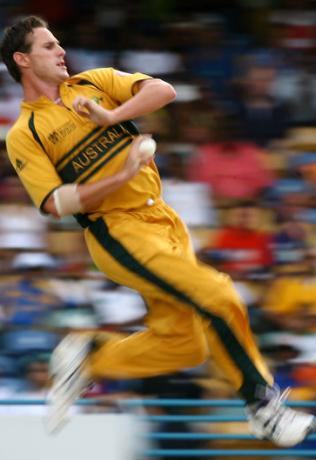 Australian cricket have gone for an aggressive wicket taking bowling unit for their Twenty20 squad for the World Cup in the West Indies and I believe it could give us an insight into the future of the Australian cricket side in all formats of the game.
Australian cricket have gone for an aggressive wicket taking bowling unit for their Twenty20 squad for the World Cup in the West Indies and I believe it could give us an insight into the future of the Australian cricket side in all formats of the game.
Australia have gone for four wicket taking quicks and a ripping leg spinner.
For Test cricket they may drop a quick to add depth to the batting but it looks a little like the formidable West Indian bowling unit of the 80’s and 90’s.
Where Australia have got it right though, is that they have gone for wicket taking bowlers, not safe, dibby dobby, medium pacers with control.
Admittedly they are the best 20 20 bowlers in Australia barring the injured Brett Lee, but they are rip snorting new ball bowlers as well. As for spin we have the ‘Boys Own Story’ in Smith, the young kid from NSW who looks like a real prospect in all forms of the game.
In my experience with Pakistan they were so dangerous in the short of the game because of exactly the same bowling team structure, wicket takers.
The Australian attack has everything for the cricket connoiseur: two left arm quicks, a huge right arm, smash the deck type bowler in Tait, who is genuinely quick and Harris, a flat, quick skidder.
Disregarding the fact Nannes has retired from the longer form of the game, let’s let our imagination have its way for a moment, Nannes and Johnson running in together for Australia in Test cricket is a mouth watering prospect.
Australian 20 20 Bowling Strategy
Australian captains and coaches understand the 10 wickets takes 10 balls rule, when you select bowlers who can take wickets regularly, not only do you keep asking the batting side to establish new partnerships, but their momentum is leaked away.
They only have 120 balls to construct an innings, this gets squeezed when the structure of their innings is being broken all the time.
The pressure exerted with this type of bowling attack brings the game back toward the bowler, which in a format which has been loaded in favour of the batters, is a move in the right direction.
When you follow the 10 wickets/10 balls rule, you select bowlers who can keep breaking the game open for you, the extra runs leaked by selecting attacking bowlers is offset against the wickets taken, its a winner for the bowling side.
On the subject of wickets, quicker wickets would give us an even better balance between bat and ball, and with all due respect to the money men behind 20 20 cricket, people want to be entertained with a contest, not a slog fest.
It is thrilling to see real quicks like Steyn, Tait, Morkel and Nannes run in and smash the stumps out of the ground against a world class batter, likewise with a Warne, Kumble or Smith ripping it.
Rather a contest with batters chasing 120 against a good bowling unit than some of the slogarama dished up on the flat, lifeless batting tracks in the IPL.
And lastly, how lovely it is to see proper boundaries on a cricket field again in 20 20 cricket, there is no skill in mishitting a ball 60 metres, the boundaries in the West Indies have asked questions of the batter’s nerve, scope of ambition and skill.
Not that it has stopped the better long ball hitters endangering the tourists in the stands.

About Richard Pybus
I'm Richard Pybus, I've coached Pakistan, Bangladesh, Middlesex, Titans and the Cape Cobras in South Africa and the goal of this site is to help you to play winning cricket.
